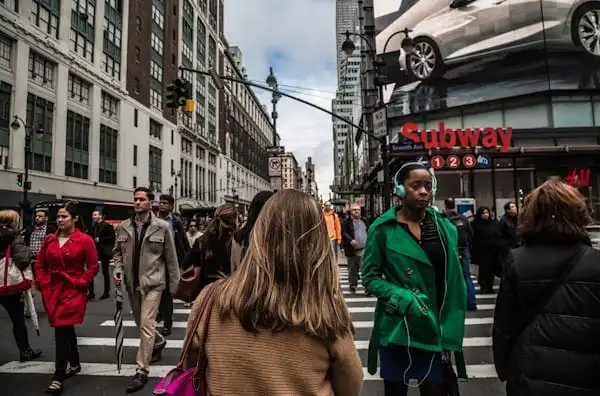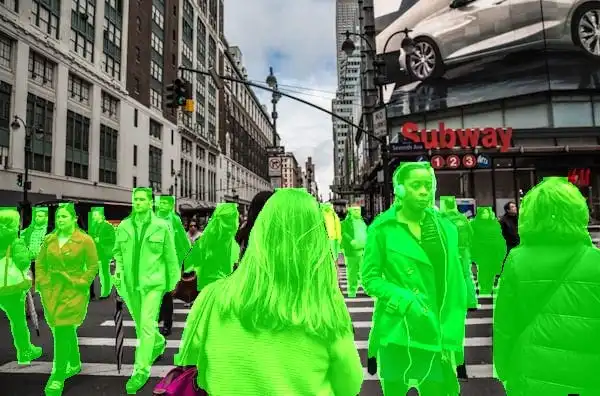本文教程将一起学习如何利用 YOLO11 分割模型在图像中准确隔离和识别人物。

YOLO11 实例分割模型在 Unsplash 图片上的结果
引言
实例分割是检测和隔离图像中单个对象的关键技术,YOLO11 是执行这项任务的最佳模型之一。在本文中,你将学习如何使用 YOLO11 分割模型有效地在图像中分割人物。我们将涵盖从设置 Python 环境和安装必要的库,到下载测试图像和可视化分割结果的所有内容。通过本教程的学习,你将清楚地了解如何应用 YOLO11 进行准确的人物分割。
1. 创建 Python 环境
我们首先将设置一个 Python 虚拟环境来管理依赖项。打开你的终端并运行:
python -m venv env激活虚拟环境
然后我们需要激活我们的虚拟环境。根据你的机器,你可能需要使用不同的命令。这里我展示了在 Windows 和 Mac/Linux 上的两种方式。Windows:
.\env\Scripts\activateMac/Linux:
source env/bin/activate2. 安装 Ultralytics 库
在我们的虚拟环境激活后,我们需要安装 ultralytics 库,这将允许我们使用 YOLO11 实例分割模型。运行以下命令在你的环境中安装库:
pip install ultralytics3. 下载测试图像
现在让我们从 Unsplash 下载一张测试图像,你可以使用你选择的任何图像。我为我们的测试目的选择了以下图像:

在 .py 文件中,添加以下代码来下载图像:
import cv2
import urllib.request
url, filename = ("https://images.unsplash.com/photo-1484353371297-d8cfd2895020?w=600&auto=format&fit=crop&q=60&ixlib=rb-4.0.3&ixid=M3wxMjA3fDB8MHxzZWFyY2h8NTUwfHxwZW9wbGV8ZW58MHx8MHx8fDA%3D", "scene.jpg")
urllib.request.urlretrieve(url, filename) # Download the image
# Load the input image using OpenCV
image = cv2.imread(filename)4. 加载模型并生成推理结果
下一步是加载我们的分割模型并在测试图像上运行推理。在本教程中,我们将使用 yolo11n-seg.pt 模型,但你可以使用 Ultralytics YOLO11 文档中的任何你喜欢的模型。一旦我们的模型加载完毕,我们使用 results = model(filename) 在测试图像上运行推理,然后创建一个空的分割掩码。
from ultralytics import YOLO
import numpy as np
# Load the model
model = YOLO("yolo11n-seg.pt") # load an official YOLO model
# Predict with the model
results = model(filename) # predict on an image
# Create an empty mask for segmentation
segmentation_mask = np.zeros_like(image, dtype=np.uint8)5. 可视化人物分割掩码
最后一步是可视化我们的模型生成的分割掩码。YOLO11 模型支持同时分割多个类别,如人物、自行车和汽车等。由于我们只对人物类别感兴趣,类别标签为 0,我们只可视化具有此类别的掩码。在下面的代码中,我们遍历结果并过滤人物掩码。然后我们将掩码叠加在图像上进行清晰的可视化,然后使用 matplotlib 保存并显示结果。
# Iterate over the results
for i, r in enumerate(results):
# Iterate through the detected masks
for j, mask in enumerate(r.masks.xy):
# Convert the class tensor to an integer
class_id = int(r.boxes.cls[j].item()) # Extract the class ID as an integer
# Check if the detected class corresponds to 'person' (class ID 0)
if class_id == 0:
# Convert mask coordinates to an integer format for drawing
mask = np.array(mask, dtype=np.int32)
# Fill the segmentation mask with color
cv2.fillPoly(segmentation_mask, [mask], (0, 255, 0))
# Combine the original image with the segmentation mask
segmentation_result = cv2.addWeighted(image, 1, segmentation_mask, 0.7, 0)
# Save the output image with segmentation
cv2.imwrite("output_segmentation.jpg", segmentation_result)
# Optionally display the image (make sure you're running in a GUI environment)
cv2.imshow("Segmentation Result", segmentation_result)
cv2.waitKey(0)
cv2.destroyAllWindows()如果所有代码都运行良好,你应该得到与下面类似的输出。这显然会有所不同,如果你使用了不同的测试图像。

分割结果
完整代码:https://github.com/Brianhulela/yolo11_segmentation











































